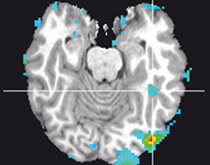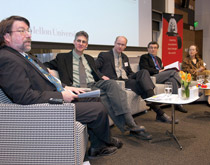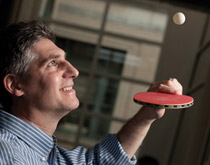The young boy gazes from his front yard to the end of the quiet cul-de-sac, two blocks from Carnegie Mellon. His parents moved to the street after his father, Joel Tarr, accepted a joint faculty position in the university’s history department in 1967. Each morning, five-year-old Michael is mesmerized by the parade of professors and students walking along Forbes Avenue to campus. Often among them is a serious-looking gentleman with thick, dark glasses. It’s Herb Simon, the father of artificial intelligence, who is making fundamental contributions to the field of cognitive psychology and would go on to receive a Nobel Prize in economics. Tarr’s father points out the influential scientist and one day introduces his son to the future Nobel laureate. On occasion, the boy and professor chat.
When the youngster reaches school age, he rides in a carpool with the children of neighbor Raj Reddy, a new faculty member at Carnegie Mellon who would become the founding director of The Robotics Institute and a dean of the School of Computer Science. Reddy would also later win a Turing Award, often dubbed the Nobel of computer science, for his work in artificial intelligence systems.
This is quite a neighborhood, and it’s one where Michael Tarr seems to fit in nicely. His father, now 77, amassed his own academic accomplishments as a world-renowned author and researcher regarding the environmental history of cities and technologies. Maybe that’s why he wasn’t impressed when his son, still in elementary school, could outperform him in mathematics. "But I knew it was all over when Michael began to beat me at ping-pong," the elder Tarr recalls, laughing.
Michael's mother, a developmental psychologist, passed away suddenly when he was six, leaving his father to raise him and his younger sister. With his dad working hard to secure tenure, the Carnegie Mellon campus becomes a second home to the young boy. He spends hour after hour playing on the Cut and often attends Tartan football games.
When he sprouts into a tall, lanky teenager, the terminal room in Science Hall (now Wean Hall) becomes one of his favorite hangouts. "I was bored with high school, plus they had better computers," he says. It's also where he first overhears discussion about advances in artificial intelligence. A science fiction devotee, he is captivated by the idea that human cognitive skills could be automated. During his senior year of high school, he takes an introductory class in cognitive psychology at Carnegie Mellon and another course in creativity in engineering. He also works as a computer programmer for several economists and psychologists.
The African proverb says it takes a village to raise a child, and for the younger Tarr, there's no doubt that village is Carnegie Mellon. "You really had a sense that you were in a university community, and Michael took advantage of it," his father says. There comes a time, though, when every child must leave the nest; Tarr's college years are spent at Cornell where he earns an undergraduate degree in psychology. Then he attends MIT graduate school in brain and cognitive sciences. His advisor there, Steven Pinker, is studying human visual cognition, or what the brain does to translate the raw image data collected by the eye into the objects and scenes we actually perceive. It seems to Tarr like interesting research; vision is our dominant sense, and roughly one-third of the cortex is used for visual processing—a vast amount of neural real estate.

He becomes absorbed in the question of how our visual system accomplishes the task of recognizing objects. Every day, we routinely identify hundreds of familiar and novel objects. It may seem simple to find a friend in a crowd or to identify your car in a lot, but how the brain performs this function is quite complicated—and largely unknown. "We don't have good answers for how the brain works in these cases," Tarr says. If we did, perhaps we could build better artificial vision systems or develop new therapies for people with dyslexia, autism, and other conditions that result in trouble recognizing visual patterns.
So, in graduate school, Tarr explores how people can visually recognize that 3D objects are the same even when seen under different viewing conditions. For example, you can identify a sailboat as a sailboat whether it's night or day, whether the vessel is moving toward you or tacking away. Prevailing wisdom held that we reconstruct a singular 3D model in our minds of an object and call up that same model every time we see the object under different viewing conditions. Tarr and Pinker test this notion through experiments that measure how long it takes people to recognize new and familiar shapes in various orientations. They are astonished by their results, finding that we actually encode a unique image of an object each time we see it. In other words, our representation of an object isn't a single 3D model, but rather a collection of such snapshots, in visual memory that we draw upon to recognize objects from different vantage points.
"Well-known people in the field were completely against the idea, and it was a very pitched battle for about 10 years," Tarr recounts. "I was having a hard time getting grants and publishing papers. But I think most people are convinced now that our approach was a different way to solve that problem." In 1998, the American Psychological Association called the discovery a "critical insight" while awarding Tarr a Distinguished Scientific Award for Early Career Contribution to Psychology. They cited his "ingenious and rigorous experimental tests" that yielded "surprising results that challenge long-standing assumptions." Today, discussion of those studies can be found in nearly any textbook on cognitive psychology.

Tarr's groundbreaking work earns him a PhD at age 27, along with an assistant professorship at Yale. His academic reputation prompts graduate student Isabel Gauthier to approach him about studying how the brain recognizes a different kind of object—the human face. Many scientists have long believed that our face-recognition system is functionally and anatomically separate from the part of the brain that recognizes other objects. It's a reasonable theory. Face recognition is one of the hardest visual discrimination tasks we perform, as we must detect slight differences in a large number of features across a wide range of facial expressions. Furthermore, our ability to recognize individuals on the basis of their faces alone is vital to us as social beings. That becomes devastatingly clear in people with autism, who have difficulty identifying faces, which experts say may contribute to the social impairment at the core of this disorder.
Gauthier tells Tarr that she wants to test this notion that faces are "special" by using functional magnetic resonance imaging (fMRI) to measure brain activity in human subjects. Tarr is intrigued by the idea and helps her devise a series of experiments. In the lab, they train research subjects to become experts in telling apart computer-generated objects called Greebles, which bear some resemblance to Yoda from Star Wars. Like faces, the Greebles vary just slightly from each other. After teaching people to identify different Greebles, the researchers then use fMRI to measure how the brain responds while carrying out this perceptual task—and they compare these results to what happens during face processing.
It's a long, costly study that continues when Tarr moves to Brown University in 1995, where he accepts a tenure-track position. He refers to the Greeble work as a "dinosaur egg" experiment. "If you incubate a dinosaur egg, the likelihood that it is going to hatch is pretty low," he says. "But if you hatch that egg, you're going to make a lot of news."
Time and again, Tarr and Gauthier find that the same systems in the brain are recruited during face processing as when people who are trained to be Greeble experts are asked to recognize them. Eventually, the preponderance of evidence becomes too powerful to ignore. The researchers conclude that our face-recognition system is actually generic and that faces aren't special after all. In the dinosaur egg analogy, Tarr and Gauthier just hatched a T. Rex. "It was intense," recalls Gauthier, now a psychology professor at Vanderbilt. "The proponents of the idea that faces are special were quite challenged by what we were doing, and there was a lot of arguing."
Just like during his dissertation research, Tarr can't believe these findings run so counter to conventional wisdom. "I've had this a couple times in my life, when you sit back after you analyze your data, and you go, ‘Holy cow!'" he says.
These Greeble studies resonated through the field of cognitive neuroscience, igniting debate about whether there are highly specialized modules used exclusively for a single activity or broad neural networks that can be mobilized for many tasks, explains Tarr's longtime colleague Marlene Behrmann, a Carnegie Mellon psychology professor. "The controversy still hasn't been settled, and the fires may rage for many years to come," she says. How this question is ultimately resolved will, she predicts, have major implications for our understanding of human perception.
Tarr spends the next decade at Brown conducting further research in the field now known as perceptual expertise—how the brain distinguishes between visually similar objects, whether they're Greebles, cars, or mushrooms. In 2001, he becomes Brown's youngest faculty member ever to receive an endowed chair. Six years later, he wins a Guggenheim Fellowship—awarded to those who have demonstrated exceptional capacity for productive scholarship—which gives him the luxury of a year-long sabbatical to concentrate on his research.
One problem, in particular, continues to vex him. He realizes that much is known about how our eyes function in the very early stages of visual processing. A fair amount is also understood about higher levels of image processing in the brain's visual cortex. But the mechanism that links these two stages—the language by which our brains learn, categorize, and remember objects—remains a mystery, Tarr says. "There is a black box in the visual system," he explains. "We don't understand very much about what I've nominally studied for 20 years. I was getting frustrated arguing with people about questions where we had no underlying facts."
To begin tackling this problem, he writes a grant application to the NIH proposing to use advanced fMRI methods to systematically map the visual cortex, identifying how collections of neurons respond to visual stimuli in real time. He likens the approach to playing the children's game "20 questions" with the brain—that is, asking the brain a series of visual questions to get it to reveal what information it's coding about objects.

It's high-risk research with no guarantee of success— far from typical in the scientific world, where grants are more often written to fund surefire projects—but it's a risk the NIH is willing to take. In 2008, the agency awards Tarr a $1.2 million, four-year EUREKA award, a grant for exceptional, unconventional research with potential to revolutionize science.
Comfortably situated at Brown, "risky research" grant in hand, he has no plans to leave Providence. But in spring 2009, he calls his father with some news: he is being recruited for a position on the psychology faculty at Carnegie Mellon and to be co-director of the Center for the Neural Basis of Cognition. The center is a joint venture of Carnegie Mellon and the University of Pittsburgh, with more than 200 affiliated faculty and trainees investigating the brain mechanisms that give rise to human intelligence and behavior.
His father is delighted by this possibility but questions whether his son would leave his prominent position in the Ivy League. It's a question that weighs on the younger Tarr's mind, too, as he considers his academic journey from Cornell to MIT to Yale to Brown. As much as he values the academic atmosphere at Brown, he says it's not an institution where, for instance, it's naturally conducive for a computer scientist to collaborate with a psychologist: "It's a liberal arts school at its core, not science-oriented like Carnegie Mellon."
Plus, with billions of neurons—each linked to thousands of other neurons—profound understanding of the brain requires the kind of strength in computer science found at Carnegie Mellon: U.S. News & World Report ranks the university's program in computer science as #1 overall, with first- and second-place rankings, respectively, in machine learning and artificial intelligence. Tarr is also aware of Carnegie Mellon's reputation as a leader in brain research, with a faculty that includes some world-class scientists:
- Marlene Behrmann, whose research awards in visual scenes recognition exceeds $5 million.
- Marcel Just, a pioneer in using fMRI to study autism, recently featured on a 60 Minutes special about brain imaging.
- Robert Kass, whose research involves the application of statistics to neuroscience, recognized by the Institute for Scientific Information as one of the 10 most highly cited researchers.
- Kenneth Koedinger, who is using computers to develop award-winning methods to improve how we learn.
- David Plaut, who has given nearly 100 invited presentations worldwide regarding his cognitive processing research.
- Nathan Urban, recognized by Scientific American as a top innovator for his research on neural networks.
Each of them says they would welcome the chance to collaborate with Tarr. "Because Mike effectively grew up on this campus, he internalized a lot of the values we all share," says Urban, "like the importance of analytical approaches and rigor and the intolerance for artificial boundaries between fields."
It's not such a surprise when Tarr makes the move to Carnegie Mellon. His research program doesn't skip a beat, as he continues his real-time fMRI studies using the state-of-the-art new scanner on the Pittsburgh campus. Soon after his arrival, he is also appointed the George A. and Helen Dunham Cowan professor of cognitive neuroscience and helps launch the Brain, Mind & Learning Initiative. The university-wide effort builds on Carnegie Mellon's strengths in brain science, generating support for researchers as they probe the mysteries of the mind. How do children learn? What happens when the brain ages? What is the science behind understanding Alzheimer's disease? How do we teach computers to think? "People just don't know Carnegie Mellon is one of the best places in the world for this kind of research," says Tarr.
He adds that being back at Carnegie Mellon seems completely natural. With his father working on the floor below him in Baker Hall—and his wife, Laurie Heller, an associate teaching professor in psychology, down the hall, it truly is like coming home. Even their younger son, Sam, 4, is on campus for preschool. The couple resides just blocks from where Tarr grew up and where his father and wife, Tova, still live. On Friday nights, the entire family gathers for dinner to observe the Jewish Sabbath. With grandchildren in town, the elder Tarr has become the envy of his friends. "It's wonderful," he says. "Whoever expected it? And you should meet the younger ones! Michael might be very smart, but not as bright as his two sons."
No word yet on whether they can beat their grandfather at ping-pong.
Jennifer Bails is an award-winning freelance writer. She is a regular contributor to this magazine.
RELATED LINKS:
CMU's Michael J. Tarr and Nathan Urban Receive Professorships for Their Interdisciplinary Contributions to Neuroscience
(https://www.cmu.edu/news/archive/2011/January/jan24_tarrurbanchairs.shtml)
Brain & Behavior
(https://www.cmu.edu/homepage/health/2011/winter/brain-day.shtml)
Brain, Mind & Learning
(https://inspireinnovation.blogspot.com/2011/02/brain-mind-learning.html)
VIDEOS:
How to Build a Better Brain
(https://www.youtube.com/watch?v=dLSqs7qhNwQ&feature=player_embedded)
CMU scans Temple Grandin’s Brain for Autism Research
(https://www.youtube.com/watch?v=aT0zCzCp6yY&feature=player_embedded)
EDITOR’S NOTE: Michael Tarr recently moderated a panel discussion about brain, mind, and learning initiatives led by Carnegie Mellon faculty and alumni. Watch: www.youtube.com/watch?v=IA7ivt1Qz_c&feature=relmfu



